Physical principles
Fluid mechanics is concerned with the study of forces and movements of liquids and gases. Both substances are continua whose elements can easily move against each other. They are grouped together under the term fluid.
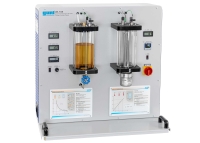
Isothermal and isochoric change of state of air
Learning objectives/experiments
- demonstrating the laws of state changes in gases experimentally
- isothermal change of state, Boyle-Mariotte law
- isochoric change of state, Gay-Lussac’s 2nd law
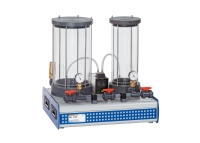
Determination of the adiabatic exponent according to Clément-Desormes
Learning objectives/experiments
- determination of the adiabatic exponent according to Clément-Desormes
- adiabatic change of state of air
- isochoric change of state of air

Pressure and temperature measurement in a steam boiler
Learning objectives/experiments
- recording the vapour pressure curve of water
- presentation of the relationship between pressure and temperature in a closed system
- temperature and pressure measurement
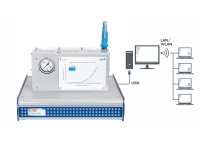
Pressure and temperature measurement in a steam boiler, software-supported experiments and evaluation
Learning objectives/experiments
- recording the vapour pressure curve of water
- presentation of the relationship between pressure and temperature in a closed system
- temperature and pressure measurement
- Marcet boiler experiment
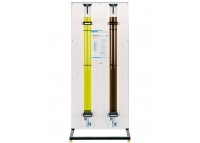
Vertically falling body in liquid using specimens of different sizes and different materials
Learning objectives/experiments
- influence of the following parameters on the settling velocity of spheres:
- diameter of the sphere
- density of the sphere
- density of the fluid
- viscosity of the fluid
In fluid mechanics, the measurement of temperature, pressure and flow rate are of particular interest.
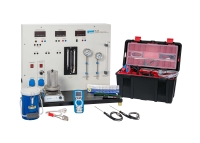
Experimental introduction to temperature measurement: methods, areas of application, characteristics
Learning objectives/experiments
- learning the fundamentals of temperature measurement by experimentation
- familiarisation with the various methods, their areas of application and special features
- non-electrical methods: gas- and liquid-filled thermometers, bimetallic thermometers and temperature measuring strips
- electrical methods: thermocouple, resistance thermometer Pt100, thermistor (NTC)
- determining air humidity with a psychrometer
….
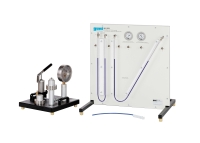
Measurement of positive and negative pressure with different measuring devices
Learning objectives/experiments
- familiarisation with 2 different measuring methods:
- direct method with U-tube manometer and inclined tube manometer
- indirect method with Bourdon tube pressure gauge
- principle of a Bourdon tube pressure gauge
- calibrating mechanical manometers
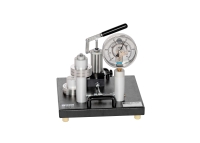
Operation of a Bourdon tube pressure gauge and a piston manometer
Learning objectives/experiments
- working principle of a Bourdon tube pressure gauge
- calibrate manometers, read off applied pressure
- determine systematic errors
- principle of operation and working with a piston manometer
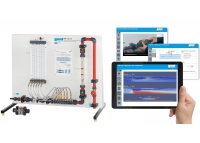
Comparison of different measuring methods and determining the flow coefficient
Learning objectives/experiments
- flow measurement with
- orifice plate flow meter and measuring nozzle
- Venturi nozzle
- rotameter
- pressure measurement with Pitot tube
….
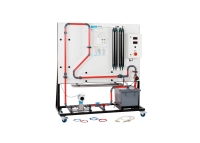
Comparison and calibration of different flow meters
Learning objectives/experiments
- together with different flow meters available as accessories
- different flow meters and their principles of operation
- calibration of different flow meters
- position dependency of flow meters
- plotting and comparison of pressure loss curves
Hydrostatics is the study of fluids at rest.
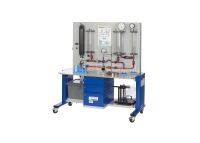
Experiments on buoyancy, density, capillarity etc.; various methods of pressure measurement
Learning objectives/experiments
- study of buoyancy on a variety of bodies
- study of the density of liquids
- hydrostatic pressure, Pascal’s law
- communicating vessels
- determination of the centre of pressure
….
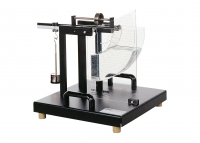
Investigation of fluid pressure on vessel walls
Learning objectives/experiments
- pressure distribution along an effective area in a liquid at rest
- lateral force of the hydrostatic pressure
- determination of the centre of pressure and centre of area
- determination of the resulting compressive force
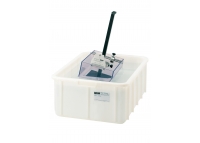
Determining metacentre and buoyancy; rectangular frame cross-section
Learning objectives/experiments
- study and determination of
- buoyancy, centre of buoyancy
- centre of gravity, metacentre, stability
- heel
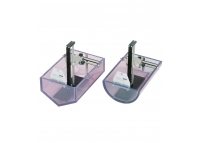
Comparison of two different frame shapes: hard chine and round bilge
Learning objectives/experiments
- comparison of two different frame shapes: hard chine and round bilge
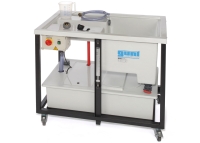
Volumetric flow measurement for large and small flow rates
Learning objectives/experiments
Together with the accessories HM 150.01 – HM 150.39:
- introduction to the fundamentals of fluid mechanics
- GUNT Media Center, develop digital skills
- E-Learning course with fundamental knowledge and calculations
- prepared CFD simulations for flow visualisation
….
Hydrodynamics is concerned with the study and description of fluids in motion. The main emphasis is the teaching of the conservation laws of mass, energy and momentum.

Base module for experiments in fluid mechanics, system control via PLC
Learning objectives/experiments
- GUNT software content adapted to the specific accessories with
- info: device description and learning module with theoretical fundamentals
- experiment preparation: guided experimental setup
and automatic bleeding of the experimental section - experiment overview: digital recording of measured values with graphical representation
….
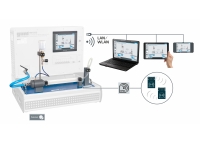
Visualisation of laminar and turbulent flow
Learning objectives/experiments
- visualisation of
- laminar flow
- transition zones
- turbulent flow
- secondary flow in a pipe elbow
….

Measurement of laminar and turbulent flow
Learning objectives/experiments
- representation of the flow profile
- determination of local and averaged flow velocity
- effect of the Reynolds number on the flow profile
- recognise differences between laminar and turbulent flow formation
- pipe friction / shear stress
….
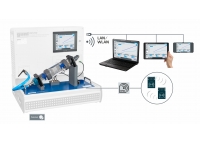
Relationship between cross-sectional area traversed and flow velocity
Learning objectives/experiments
- investigation of the continuity equation
- demonstration of conservation of mass
- identification of the influencing variables
- cross-sectional flow area
- pitch of the impellers
….
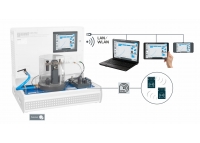
Demonstration of the principle of linear momentum; interchangeable deflectors with different deflection angles
Learning objectives/experiments
- application of the momentum equation
- measurement of the jet forces
- investigate influencing variables of jet forces
- deflection angles
- nozzle pre-pressure
….
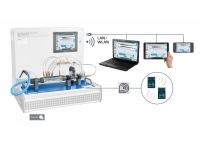
Static pressure and total pressure distribution along the Venturi nozzle
Learning objectives/experiments
- energy conversion in divergent/convergent flow
- record the pressure curve in the Venturi nozzle
- determine the velocity curve in the Venturi nozzle
- qualitative evaluation of pressure losses
- identify influences of nozzle and diffuser on pressure loss
….
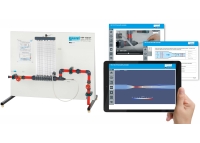
Static pressure and total pressure distribution along the Venturi nozzle
Learning objectives/experiments
- energy conversion in divergent/convergent pipe flow
- recording the pressure curve in a Venturi nozzle
- recording the velocity curve in a Venturi nozzle
- determining the flow coefficient
- recognising friction effects
….
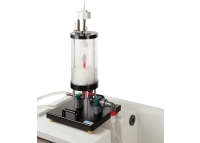
Demonstration of the principle of linear momentum; interchangeable deflectors with different deflection angles
Learning objectives/experiments
- demonstration of the principle of linear momentum
- study of the jet forces
- influence of flow rate and flow velocity
- influence of different deflection angles
….
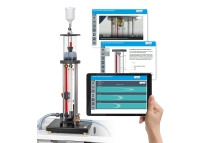
Visualisation of laminar and turbulent flow
Learning objectives/experiments
- visualisation of laminar flow
- visualisation of the transition zone
- visualisation of turbulent flow
- determination of the critical Reynolds number
….




